How School Districts Can Improve Mental Health for Students
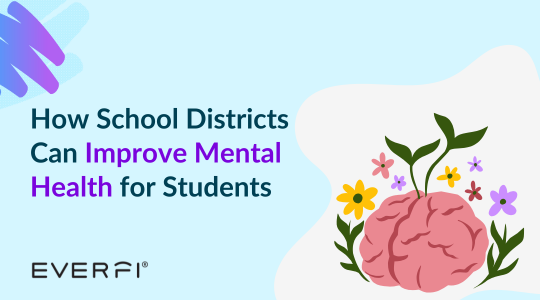

According to the Centers for Disease Control (CDC), the number of adolescent students reporting mental health issues is increasing. In fact, a 10-year study that concluded in 2023 found that about 40% of teens in the United States experienced persistent feelings of sadness and/or hopelessness, and 9% of students attempted suicide. The figures are harrowing, and administrators, teachers, and parents alike are working to figure out how schools can help with mental health.
School districts are working hard to take action and provide students with the mental health support they need to thrive. There are many factors, however, that can complicate offering mental health services in schools, including a lack of resources within the district. Here, we’ll delve into actionable strategies that school districts can take to support student mental health and how EVERFI’s free resources can provide mental health support for in school environments.
The Mental Health Foundation found that nearly 8 million children and adolescents in the United States are living with a serious mental illness. It’s estimated that about 50% of chronic mental health issues begin by age 14, making early identification and treatment of mental health issues paramount to student well-being.
Mental health issues can affect students in many ways, including:
Academic performance: Students with mental health issues may have lower grades, be absent from school more frequently, and be more likely to drop out of school. They may also struggle to concentrate, retain information, and complete work. Students who have high cognitive abilities may struggle to reach their full potential when the symptoms of mental illness hold them back.
Behavior: Students who have mental health issues may be more likely to be unhappy at school or at home. They may also have problems developing supportive peer relationships, and they may be more likely to engage in high-risk behaviors, such as drug and alcohol use.
Long-term well-being: Untreated mental illness can have long-term consequences for students that can affect their future employment, earning potential, education, and overall health.
Many students are in desperate need of mental health services but are unsure of where to turn to get the help they need. It’s essential that schools provide a safe haven equipped with reliable support to protect and serve students who are living with mental illness.
Offering ongoing mental health education can help students recognize signs of mental health problems in themselves and others, allowing them to get help immediately.
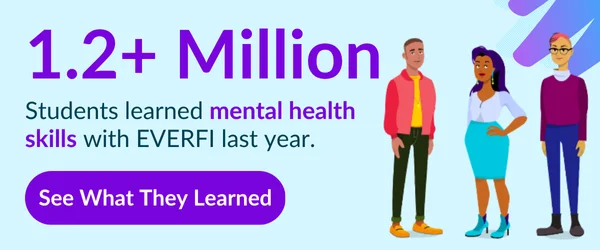
Many administrators, parents, and teachers are searching for answers to questions like, “How can schools help students with mental health issues?” Thankfully, there are effective steps that can be taken to address mental health in high school students, as well as for younger students.
Creating a supportive, caring, nurturing environment is the first step on the path of supporting student mental health and well-being. Creating an inclusive atmosphere where students feel appreciated — not judged — can make all the difference as to whether a student feels comfortable speaking up when they need help.
Promoting mental health awareness in schools is integral to creating a healthy, supportive environment for students. Integrating lessons on mental health, emotional regulation, stress management, and common mental health issues can provide students with a springboard to learn more about how they can support themselves and others and when to reach out for help.
24% more students report being likely to talk to friends about mental health problems after completing EVERFI’s free Understanding Mental Wellness resource.
Creating a culture of inclusion in which differences are celebrated can help students feel accepted and may make them more likely to reach out when they’re in need of support. Administrators and teachers must model respect, inclusivity, and kindness, as some students may have few examples of empathy outside of school. Creating a culture of open dialogue can also be helpful. Letting students know that it’s OK to simply share their feelings can be a step in the direction of creating a supportive environment.
In many cases, teachers and other school staff members are the first line of defense when it comes to identifying and addressing issues regarding student mental health in schools.
Many educators, however, feel unqualified or unprepared to recognize and respond to mental health warning signs.
Comprehensive training programs can help educators to recognize mental health issues and intervene confidently when necessary. Providing teachers and other staff members with professional development on mental health topics (such as recognizing mental health issues in students, breaking the stigma about mental health, and supporting students who have experienced trauma) can help teachers identify and provide initial care for students who need mental health support.
Social-emotional learning programs are essential for developing well-rounded students who are emotionally intelligent, resilient, and equipped to navigate the ups and downs of a career, relationships, and other aspects of non-academic life. SEL can help students develop critical life skills, including empathy, communication, problem-solving, and emotional regulation.
There’s no need to treat SEL as a standalone subject; rather, it can be integrated into existing learning areas. Incorporating SEL into classroom lessons (for example, discussing how scientists with different hypotheses may work to communicate effectively and resolve conflicts) can provide a low-pressure framework for educators to begin addressing and modeling social and emotional issues.
Declaring school-wide social-emotional focus areas can help keep staff and students on the same page. For example, one month’s focus might be empathy, another might be teamwork, etc. Teachers and administrators can implement these facets of SEL into daily lessons, assemblies, advisory periods, and interactive activities.
When students have access to mental health resources at school, they can boost their grades, improve behavior in the classroom, and create better peer relationships. Access to mental health resources also allows students to connect with trustworthy adults, allowing students to see that asking for help is a powerful tool.
25% more students report being likely to talk to ask a trusted adult for help dealing with bullying after completing EVERFI’s free Honor Code – Bulling Prevention resource.
Research shows that community partnerships — such as those between a school and a mental wellness organization, hospital, or social work organization — can help increase the number of children who are able to get mental health support at school.
Without the option to ask for help at school, many students are left to talk to their parents about what’s going on or suffer in silence. Embarrassment, fear, and shame can all make it harder for a student to speak with a parent, and many find it easier to ask for mental health support from a professional they can access at school.
Remember, resources are only effective if students are aware that they’re available. Promoting mental health awareness in schools is key for helping students understand the mental health services at their disposal.
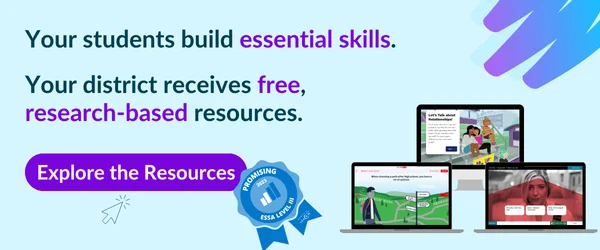
Myth: Mental health care is too expensive for schools.
Fact: Many schools struggle to provide mental health resources due to budgetary constraints, but offering mental health support doesn’t have to be excessively expensive. Implementing EVERFI’s free mental health lessons, developing a mentorship program, or forging a partnership with a provider in the community can all help schools provide no- or low-cost services to students.
Myth: Students don’t utilize school counselors.
Fact: While many students go to their school counselor for mental health support, counselors also provide academic and college counseling. School counselors have a lot on their plate and a lot of students to support, leading to most students only seeing their counselor at least once each year.
Myth: Preventative mental health programs don’t work.
Fact: Current research shows that preventative mental health care can lower the likelihood of long-term problems in students experiencing specific forms of adversity (such as divorce, parental substance use, bereavement, etc.). EVERFI’s National Report on Mental Wellness Education shows that students are 26% more confident in their ability to handle stress from relationships after taking mental health lessons.
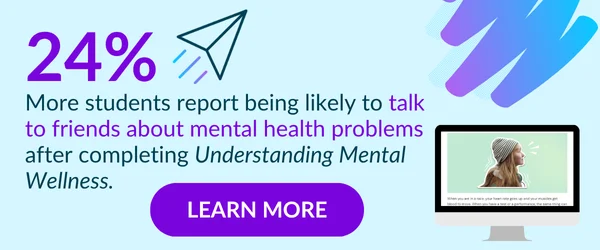
At EVERFI, our team is here to provide schools with free mental health lessons that align with CASEL and state standards and contribute to the development of a positive school culture.
Our mental health programs are ideal for supplementing your district’s current mental health initiatives. When you choose EVERFI, you’re getting research-backed, trusted curricula that you can count on to provide measurable outcomes that support the mental health and well-being of your students.
“I love that The Compassion Project [not only] aligns with what I am already required to teach but offers a new and exciting approach. Students were asking to work on the modules in their free time.” – Elementary Teacher (Educator Survey)
With seven digital resources to choose from, EVERFI’s popular mental health suite covers topics like:
Be sure to check back regularly — we’re constantly updating our course offerings based on the needs of our schools.
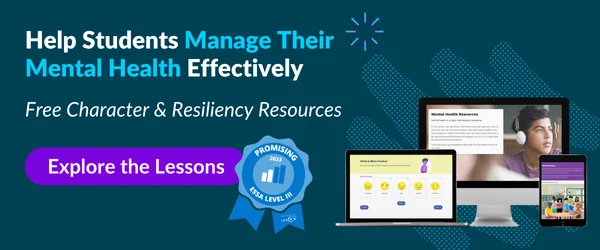
If you’re ready to expand the number of mental health resources and services in your district (& not have to pay for it), the team at EVERFI is here to help.
We believe in your commitment to creating a safe, inclusive, supportive environment for all students, and we’re excited to talk with you about how we can be a part of your district’s student mental health and wellness initiative at no cost to your district.
We’d love to set up a time to chat about our PD opportunities that can help educators effectively implement mental health resources, as well as our award-winning resources that provide students with the mental health education necessary to support themselves and others.

Amanda Berkey is a Pennsylvania-based writer and reporter with an M.S.Ed. in School and Mental Health Counseling. With 17 years of experience in education, she has taken on diverse roles in teaching, coaching, and administration.
Thanks to partners, we provide our digital platform, training, and support at no cost.
See why 3 out of 5 districts partner with EVERFI.
Everfi uses anonymous data provided by cookies to improve site navigation, analyze site usage, and assist in our marketing efforts. Click to accept or choose your opt-out preferences.